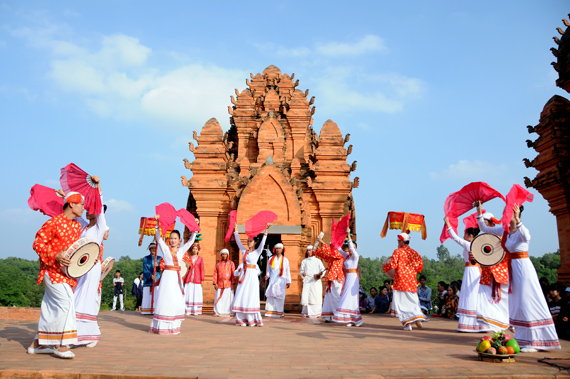The Chams (Cham: ꨌꩌ, چام, cam), or Champa people (Cham: ꨂꨣꩃ ꨌꩌꨛꨩ, اوراڠ چامفا, Urang Campa; Vietnamese: Người Chăm or Người Chàm; Khmer: ជនជាតិចាម, Chônchéatĕ Cham), are an Austronesian ethnic group in Southeast Asia and are the original inhabitants of central Vietnam and coastal Cambodia before the arrival of the Cambodians and Vietnamese, during the expansion of the Khmer Empire (802–1431) and the Vietnamese conquest of Champa (11th–19th century).
From the 2nd century, the Chams founded Champa, a collection of independent Hindu-Buddhist principalities in what is now central and southern Vietnam. By the 17th century, Champa became an Islamic sultanate. Today, the Cham people are largely Muslim, with a minority following Hinduism, both formed the indigenous Muslim and Hindu population in both Cambodia and Vietnam. Despite their adherence to Islam, the Cham people still retain their ancestral practice of matriarchy in family and inheritance.
The Cham people speak Cham and Tsat (the latter is spoken by the Utsuls, a Cham subgroup on China’s Hainan Island), the two Chamic languages from the Malayo-Polynesian branch of the Austronesian family. The Cham people were one among several ethnic groups that were primarily targeted by the Khmer Rouge’s ethnic cleansing campaign during the Cambodian genocide (1975–1979).
History
This section’s factual accuracy is disputed. (February 2022)
Historical extent of the Kingdom of Champa (in green) around 1100 CE
Depiction of fighting Cham naval soldier against the Khmer, stone relief at the Bayon
For a long time, researchers believed that the Chams had arrived by sea in the first millennium BC from Sumatra, Borneo and the Malay Peninsula, eventually settling in central modern Vietnam.
The original Chams are therefore the likely heirs of Austronesian navigators from Taiwan and Borneo, whose main activities are commerce, transport and perhaps also piracy. Austronesian Chamic peoples might have migrated into present-day Central Vietnam around 3 kya to 2.5 kya (1,000 to 500 BC). With having formed a thalassocracy leaving traces in written sources, they invested the ports at the start of important trade routes linking India, China and Indonesian islands. Historians are now no longer disputing in associating the Sa Huynh culture (1000 BC–200 AD) with the ancestors of the Cham people and other Chamic-speaking groups.
Patterns and chronology of migration remain debated and it is assumed that the Cham people, the only Austronesian ethnic group originated from South Asia, arrived later in peninsular Southeast Asia via Borneo. Mainland Southeast Asia had been populated on land routes by members of the Austroasiatic language family, such as the Mon people and the Khmer people around 5,000 years ago. The Chams were accomplished Austronesian seafarers that from centuries populated and soon dominated maritime Southeast Asia. Earliest known records of Cham presence in Indochina date back to the second century CE. Population centers were located on the river outlets along the coast. As they controlled the import/export trade of continental Southeast Asia, they enjoyed a prosperous maritime economy.
Cham folklore includes a creation myth in which the founder of the Cham people was a certain Lady Po Nagar. According to Cham mythology, Lady Po Nagar was born out of sea foam and clouds in the sky. However, in Vietnamese mythology, which adopted the goddess after taking over the Champa kingdom, her name is Thiên Y A Na and she instead came from a humble peasant home somewhere in the Dai An Mountains, Khánh Hòa Province, spirits assisted her as she traveled to China on a floating log of sandalwood where she married a man of royalty and had two children. She eventually returned to Champa “did many good deeds in helping the sick and the poor” and “a temple was erected in her honor”.
Early history
The Chams decorated their temples with stone reliefs depicting the gods such as garuda fighting the nāga (12th-13th century CE)
Like countless other political entities of Southeast Asia, the Champa principalities underwent the process of Indianization since the early common era as a result of centuries of socio-economic interaction adopted and introduced cultural and institutional elements of India. From the 8th century onward, Muslims from such regions as Gujarat began to increasingly appear in trade and shipping of India. Islamic ideas became a part of the vast tide of exchange, treading the same path as Hinduism and Buddhism centuries before. Cham people picked up these ideas by the 11th century. This can be seen in the architecture of Cham temples, which shares similarities with the one of the Angkor temples. Ad-Dimashqi writes in 1325, “the country of Champa… is inhabited by Muslims and idolaters. The Muslim religion came there during the time of Caliph Uthman… and Ali, many Muslims who were expelled by the Umayyads and by Hajjaj, fled there”. Encounter with Islam
Depiction of Cham people in the Boxer Codex from 1590
Islam first arrived in Champa around the ninth century; however, it did not become significant among the Cham people until after the eleventh century.
Chams who migrated to Sulu were Orang Dampuan. Champa and Sulu engaged in commerce with each other which resulted in merchant Chams settling in Sulu where they were known as Orang Dampuan from the 10th-13th centuries. The Orang Dampuan were slaughtered by envious native Sulu Buranuns due to the wealth of the Orang Dampuan. The Buranun were then subjected to retaliatory slaughter by the Orang Dampuan. Harmonious commerce between Sulu and the Orang Dampuan was later restored. The Yakans were descendants of the Taguima-based Orang Dampuan who came to Sulu from Champa. Sulu received civilization in its Indic form from the Orang Dampuan.
21st century
The Chams in Vietnam are officially recognized by the Vietnamese government as one of 54 ethnic groups. There has also been wide-reaching recognition of the historical Champa Kingdom.
An attempt at Salafist expansion among the Chams in Vietnam has been halted by Vietnamese government controls; however, the loss of the Salafis among Chams has been to the benefit of Tablighi Jamaat.
There is evidence that some Acehnese people of Aceh, Sumatra, Indonesia are descendants of Cham refugees who fled after defeat by the Vietnamese polity in the 15th century.
Geography
Eastern Chams (also known as Panduranga Chams or Phan Rang Chams) and their related ethnic groups, Raglai and Churu, are a major minority in Panduranga region in Bình Thuận and Ninh Thuận provinces of Vietnam. The Haroi Chams mainly populate in Đồng Xuân district of Phu Yen and Vân Canh district of Bình Định province. They are the core of the Hindu and Bani population.
Culture
The Cham culture is diverse and rich because of the combination of indigenous cultural elements (plains culture, maritime culture, and mountain culture) and foreign cultural features (Indian cultures and religions such as Buddhism; early Han Chinese influences; Islam) (Phan Xuan Bien et al. 1991:376). The blend of indigenous and foreign elements in Cham culture is a result of ecological, social, and historical conditions. The influences of various Indian cultures produced similarities among many groups in Southeast Asia such as the Chams, who traded or communicated with polities on the Indian subcontinent. However, the indigenous elements also allow for cultural distinctions. As an example, Brahmanism became the Ahier religion, while other aspects of influence were changed, to adapt to local Ahier characteristics and environment. The blending of various cultures has produced its own unique form through the prolific production of sculptures and architecture only seen at the Champa temple tower sites.
Language
The Cham language is part of the Austronesian language family. Although sparse, Cham literary tradition is ancient, dating back to the 4th century AD. The Dong Yen Chau inscription, written in old Cham, is the oldest known attestation of an Austronesian language. Cham is very rich with many loan words and terminology influenced by many other languages it came into contact with. Most Chams speak the language though many also speak the dominant language of the nation they reside in like Vietnamese, Khmer, Malay and others. Some Chams can also speak and write Arabic.
Cham is written in Eastern Cham script in Central Vietnam while the language is predominantly written in Jawi Arabic script around the Mekong Delta. Western Cham script, used in Cambodia, is different enough from Eastern Cham’s to be under review by the Unicode Consortium for inclusion as its own block — as of 2022, the character set is still being revised.
Religion
The first recorded religion of the Champa was a form of Shaiva Hinduism, brought by sea from India. Hinduism was the predominant religion among the Cham people until the sixteenth century. Numerous temples dedicated to Shiva were constructed in the central part of what is now Vietnam. The jewel of such temple is Mỹ Sơn. It is often compared with other historical temple complexes in Southeast Asia, such as Borobudur of Java in Indonesia, Angkor Wat of Cambodia, Bagan of Myanmar and Ayutthaya of Thailand. As of 1999, Mỹ Sơn has been recognised by UNESCO as a world heritage site.
source: https://en.m.wikipedia.org/wiki/Chams

